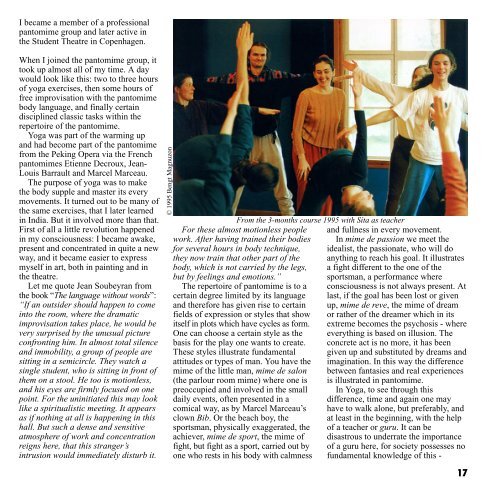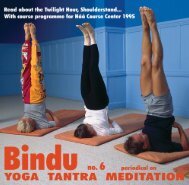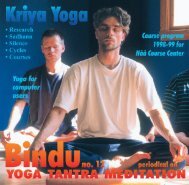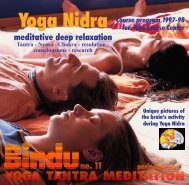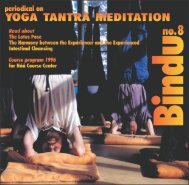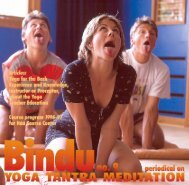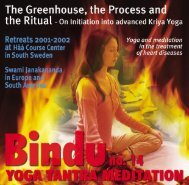Bindu 23 - engelsk 7.p65 - Scandinavian Yoga and Meditation School
Bindu 23 - engelsk 7.p65 - Scandinavian Yoga and Meditation School
Bindu 23 - engelsk 7.p65 - Scandinavian Yoga and Meditation School
You also want an ePaper? Increase the reach of your titles
YUMPU automatically turns print PDFs into web optimized ePapers that Google loves.
I became a member of a professional<br />
pantomime group <strong>and</strong> later active in<br />
the Student Theatre in Copenhagen.<br />
When I joined the pantomime group, it<br />
took up almost all of my time. A day<br />
would look like this: two to three hours<br />
of yoga exercises, then some hours of<br />
free improvisation with the pantomime<br />
body language, <strong>and</strong> finally certain<br />
disciplined classic tasks within the<br />
repertoire of the pantomime.<br />
<strong>Yoga</strong> was part of the warming up<br />
<strong>and</strong> had become part of the pantomime<br />
from the Peking Opera via the French<br />
pantomimes Etienne Decroux, Jean-<br />
Louis Barrault <strong>and</strong> Marcel Marceau.<br />
The purpose of yoga was to make<br />
the body supple <strong>and</strong> master its every<br />
movements. It turned out to be many of<br />
the same exercises, that I later learned<br />
in India. But it involved more than that.<br />
First of all a little revolution happened<br />
in my consciousness: I became awake,<br />
present <strong>and</strong> concentrated in quite a new<br />
way, <strong>and</strong> it became easier to express<br />
myself in art, both in painting <strong>and</strong> in<br />
the theatre.<br />
Let me quote Jean Soubeyran from<br />
the book “The language without words”:<br />
“If an outsider should happen to come<br />
into the room, where the dramatic<br />
improvisation takes place, he would be<br />
very surprised by the unusual picture<br />
confronting him. In almost total silence<br />
<strong>and</strong> immobility, a group of people are<br />
sitting in a semicircle. They watch a<br />
single student, who is sitting in front of<br />
them on a stool. He too is motionless,<br />
<strong>and</strong> his eyes are firmly focused on one<br />
point. For the uninitiated this may look<br />
like a spiritualistic meeting. It appears<br />
as if nothing at all is happening in this<br />
hall. But such a dense <strong>and</strong> sensitive<br />
atmosphere of work <strong>and</strong> concentration<br />
reigns here, that this stranger’s<br />
intrusion would immediately disturb it.<br />
© 1995 Bengt Magnuzon<br />
From the 3-months course 1995 with Síta as teacher<br />
For these almost motionless people<br />
work. After having trained their bodies<br />
for several hours in body technique,<br />
they now train that other part of the<br />
body, which is not carried by the legs,<br />
but by feelings <strong>and</strong> emotions.”<br />
The repertoire of pantomime is to a<br />
certain degree limited by its language<br />
<strong>and</strong> therefore has given rise to certain<br />
fields of expression or styles that show<br />
itself in plots which have cycles as form.<br />
One can choose a certain style as the<br />
basis for the play one wants to create.<br />
These styles illustrate fundamental<br />
attitudes or types of man. You have the<br />
mime of the little man, mime de salon<br />
(the parlour room mime) where one is<br />
preoccupied <strong>and</strong> involved in the small<br />
daily events, often presented in a<br />
comical way, as by Marcel Marceau’s<br />
clown Bib. Or the beach boy, the<br />
sportsman, physically exaggerated, the<br />
achiever, mime de sport, the mime of<br />
fight, but fight as a sport, carried out by<br />
one who rests in his body with calmness<br />
<strong>and</strong> fullness in every movement.<br />
In mime de passion we meet the<br />
idealist, the passionate, who will do<br />
anything to reach his goal. It illustrates<br />
a fight different to the one of the<br />
sportsman, a performance where<br />
consciousness is not always present. At<br />
last, if the goal has been lost or given<br />
up, mime de reve, the mime of dream<br />
or rather of the dreamer which in its<br />
extreme becomes the psychosis - where<br />
everything is based on illusion. The<br />
concrete act is no more, it has been<br />
given up <strong>and</strong> substituted by dreams <strong>and</strong><br />
imagination. In this way the difference<br />
between fantasies <strong>and</strong> real experiences<br />
is illustrated in pantomime.<br />
In <strong>Yoga</strong>, to see through this<br />
difference, time <strong>and</strong> again one may<br />
have to walk alone, but preferably, <strong>and</strong><br />
at least in the beginning, with the help<br />
of a teacher or guru. It can be<br />
disastrous to underrate the importance<br />
of a guru here, for society possesses no<br />
fundamental knowledge of this -<br />
17


